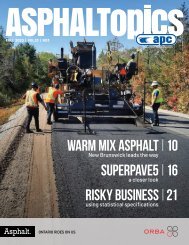ASPHALTopics | Summer 2020 | VOL 33 | NO 2
ASPHALTopics is the official publication of the Ontario Asphalt Pavement Council - A Council of the Ontario Road Builders' Association. Articles within ASPHALTopics may not be republished without express permission from OAPC.
ASPHALTopics is the official publication of the Ontario Asphalt Pavement Council - A Council of the Ontario Road Builders' Association. Articles within ASPHALTopics may not be republished without express permission from OAPC.
- No tags were found...
Create successful ePaper yourself
Turn your PDF publications into a flip-book with our unique Google optimized e-Paper software.
AI’S LCA STUDY ON ASPHALT
BINDER AND WHAT IT MEANS
TO CANADA
The Canadian paving industry has historically relied
heavily on asphalt as the building material of choice to
keep our expansive infrastructure network connected.
Asphalt provides a smooth durable surface that can last
a lifetime if designed, installed and maintained properly.
Its ability to be adaptable to various climate constraints is
critical to Canada’s diverse geography. Once on the road,
asphalt can be considered 100 per cent recyclable which
can set it apart from its competitors as a sustainable
pavement choice and provide environmental benefits.
So why would anyone question the positive impacts of
using this product? With the increasing focus over the
past few years on climate change, and asphalt binder
being a petroleum product, it became important to
understand what possible impacts asphalt binder
production has on our environment. Agencies and
owners in various industries have already been under
pressure to be environmentally accountable for the
materials they choose in their projects which could add
concerns to suppliers over meeting those standards.
Creating an LCA on asphalt binder is a way for our industry
to understand these environmental impacts in a sciencebased
approach that allows us to bring these findings
to agencies and owners using proven international
standards, not assumptions. It can act as a tool to
better understand the potential impacts of asphalt
over alternative paving options, like concrete.
Completing an LCA is not an easy task, both in effort
and cost, but the North American asphalt industry, united
under the Asphalt Institute (AI), funded and developed a
detailed plan on completing this endeavour. To have our
industry come together to undertake such an initiative
will ensure our local agencies and owners can take full
advantage of these findings for use in their project
designs, while industry can be sure that the data
inputs are as accurate as possible.
A big part of this study was supported by Canadian AI
members, including Imperial Oil, who helped to provide
funding, data and industry expertise in the development
of this robust and independently-reviewed report. The
study covers the important steps that asphalt binder
takes in its life cycle from crude oil extraction through to
finished asphalt terminal storage using various methods
throughout the flow. This helps to make sure that the LCI
data created is rigorous enough for our industry to rely
on in the years to come.
weighted average. This average asphalt production
process then provided the input of asphalt to the
average terminal process.
At the asphalt terminal, hot liquid asphalt is stored,
additives (GTR, SBS, or PPA) are mixed or milled into
the asphalt, and the asphalt is then stored. The terminals
consume electricity (mainly used for milling) and thermal
energy (used for storage). Terminals can be either colocated
with the refinery or off-site. For the study, all
participating companies were located off-site. Inbound
transportation from the refinery to the terminal is a
production weighted average of the distances and
modes collected from the companies.
RESULTS
The reported impact categories represent impact
potentials, i.e., they are approximations of environmental
impacts that could occur if the emissions (a) followed the
underlying impact pathway and (b) met certain conditions
in the receiving environment while doing so. In addition,
the inventory only captures that fraction of the total
environmental load that corresponds to the chosen
functional unit (relative approach). ››
Chris Campbell is Americas Asphalt Technical Advisor
for Imperial Oil and chair of the AI Canadian Committee.
SUMMER 2020 27


















